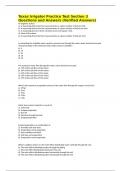Exam 1 Med surg Galen
What are the three main types of headaches? - ANS-Migraine, Tension, Cluster
Steps to Pain Assessment - ANS-Provoking
Quality
Radiation
Severity
Time
Provoking - ANS-has anything made it better or worse
Quality - ANS-Sharp, dull, achy, throbbing
Radiation - ANS-Does it radiate to another part of the body
Severity - ANS-Pain scale, 1-10 scale, intense pain, Other symptoms: N/V, photophobia
Time - ANS-how long has it been going on? how long does it usually last?
Tension Headache - ANS-Bandlike, tightness
Describe a Migraine - ANS-Unilateral, supra and retro orbital, pulsating or throbbing, worse with
movement, sensitivity with light and sounds
Cluster - ANS-Lancinationg or stabbing, 5-30 minutes. Extreme pain
Migraine Pathophysiology - ANS-Pathophysiology - Not entirely clear.; theories?
Prevalence: May be seen in children and adults; Among children more common in boys; among
adults more common in women.
History of patient with migraine: Otherwise healthy, usually female in 30's
Individualized triggers (stress, smells, foods, hormones, menses)
Tyramine rich foods- chocolate, cheeses, beer, wine, cigar, sweet and low.
Treatment for Migraine - ANS-Vasoconstriction works the best, irritation of the 5th cranial nerve,
Estrogen hormone can causes migraines.
Migraine Manifestations - ANS-Manifestations
Pain: Usually unilateral, supra/retro-orbital, pulsating. Worse with movement.
Accompanied by non-h/a symptoms: N/V, photophobia, phonophobia,
Aura: (20% of cases):
,Migraine Interventions - ANS-Pain management
Symptom management
Ex. Pitch black, turn off all the lights, N/V causes dehydration
Migraine Drug Therapy - ANS-APAP/Caffeine/ Butabital (Fioricet)
NSAIDS : Naprosyn
CCBs and Beta- Blockers (Preventative therapy) : Verapamil
Triptans and ergotamine's: Sumatriptan and Cafergot
Anticonvulsants (Preventative therapy): Topiramate
Botox Injections (monthly)
Magnesium
Migraine Complementary and alternative therapies - ANS-Acupuncture, Yoga, Stress reduction
activities, Supplemental mag, Distraction sometimes works.
Pound acronym - ANS-P:Pulsating
O:Duration
U: Unilateral location
N: N/V
D: Disabling
Epilepsy - ANS-Chronic disorder with two or more seizures experienced by the client.
Epilepsy Assessment - ANS-Inquire about the seizure activity, frequency, precipitating factors,
aura (pre-ictal phase).
Family history
Collateral medical conditions (hx stroke, HTN, TBI, drug/alcohol abuse)
Seizure risk factors - ANS-V: Vascular
I: Infection or Inherited conditions
T: Trauma
A: Alzheimers/Autoimmune
M: Metabolic derangements
I: Idiopathic
N: Neoplasm
S: pSychiatric
Epilepsy Triggers - ANS-Sleep deprivation
Stress
Alcohol/ Alcohol Withdrawl
MSG
pg 878 Chart 42-9
, Aura - ANS-Seizures often preceded by an aura; it is unique to that patient, not every patient
has them.
Somatic: rising epigastric sensation
Hallucinations: Visual, gustatory, olfactory
Halos, Zig-zags, h/a, paresthesias, psychiatric phenomenon, deja-vu
Epilepsy Partial: - ANS-Partial (also called focal or local seizures): Occurs in a specific part of
the brain. May be characterized by automatism or tic. Ex: Jerk, reflex, lip smacking (complex)
Epilepsy Simple: - ANS-Client does not consciousness. Localized jerking/movement. Strange
sensations. Autonomic symptoms.
Focal awareness they do not lose consciousness.
Epilepsy Complex - ANS-Involves altered LOC; may or may not have total loss of
consciousness. Automatisms. Patient may wander at start or have amnesia after. Most common
among older adults and difficult to diagnose bc symptoms appear similar to those of dementia,
psychosis, or neurobehavioral disorder, esp post-ictal.
Generalized epilepsy - ANS-Affects brain as a whole, bilateral seizure; we differentiate them
based on how they appear while observing them.
absence epilepsy - ANS-(petit mal): Generalized seizure involving sudden, brief loss of
consciousness. Usually diagnosed in children. Appears as if they are staring off into space.
Lasts seconds.
tonic-clonic epilepsy - ANS-"Grand mal." Stereotypical body convulsions. Lasts minutes,
involves muscle rigidity and convulsions. Tonic=stiffening, Clonic=jerking
Myoclonic Epilepsy - ANS-Brief muscle jerks, lasts seconds
Atonic (akinetic) Seizure (drop seizure) - ANS-Involves brief loss of tone. May be confused with
Fainting.
Acute Seizure Management (Observation) - ANS-History (if reported)
Look for underlying cause!
Record time sz began and ended.
Duration
Types of movements
Ongoing seizure observations
Post-ictal assessment - often involves reorientation.
Patient safety
If the client is sitting or standing, place the client on the floor
Continual assessment of the ABCs





